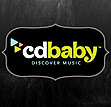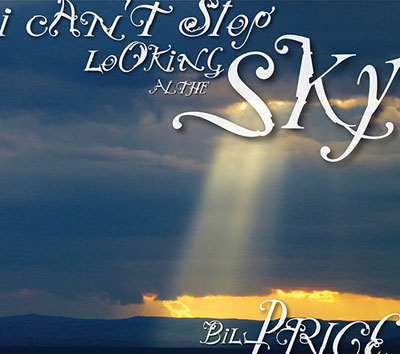 In
2015 singer-songwriter / guitarist Bill Price released his
double CD masterpiece, I Can’t Stop Looking At The Sky.
The double CD set comes with two musical journals and extensive
lyric books and the album was also released as a single CD version
sampler that draws upon various tracks that gives the listener a good
idea of the music Bill Price composes. Based in Indiana, Bill Price’s
Americana rock sounds influenced by Bob Dylan, Jackson Browne and
String Cheese Orchestra, for example. Produced by Bill and Michael
Graham, I Can’t Stop Looking At The Sky is being heralded
as a major thematic work that speaks to the universal experiences
of time, home, place, childhood, forgiveness, grace and paradox. Interviewed
by mwe3.com about the extensive research and experiences that went
into creating his double album masterpiece, Bill Price synopsized,
“In 2010, I was in need of a big break. I hadn’t been
anywhere for a long while and so I decided to return to my two favorite
places: The Black Hills in South Dakota and Glacier National Park
in Northwest Montana. Having recently become a fan of Lewis &
Clark, I decided to stop at some of their historic locations and,
like them, keep a journal. After a little over three weeks, I came
back with a lot of inspiration about life. Some of the ideas were
new and some were not. But even the older ideas, I was reenergized
about. I had planned to return and record my next album. By adjusting
some lyrics and writing some new songs, I thought that the project
could be a pretty cool thematic piece. It grew into two CDs with 34
tracks and over two hours and twenty minutes of music. The package
then got pretty elaborate, due to my graphic design background. The
idea evolved in its own way—kind of asking to be done—in
a rather organic fashion.” With Bill handling all the composing
and lead vocals, a number of quite talented musicians also appear
backing up his wide-screen pop-rock vision. One of the most meticulously
packaged, produced and recorded double albums of the decade, I
Can’t Stop Looking At The Sky is a well-rounded example of
Americana pop-rock at its best. www.BillPrice.info
In
2015 singer-songwriter / guitarist Bill Price released his
double CD masterpiece, I Can’t Stop Looking At The Sky.
The double CD set comes with two musical journals and extensive
lyric books and the album was also released as a single CD version
sampler that draws upon various tracks that gives the listener a good
idea of the music Bill Price composes. Based in Indiana, Bill Price’s
Americana rock sounds influenced by Bob Dylan, Jackson Browne and
String Cheese Orchestra, for example. Produced by Bill and Michael
Graham, I Can’t Stop Looking At The Sky is being heralded
as a major thematic work that speaks to the universal experiences
of time, home, place, childhood, forgiveness, grace and paradox. Interviewed
by mwe3.com about the extensive research and experiences that went
into creating his double album masterpiece, Bill Price synopsized,
“In 2010, I was in need of a big break. I hadn’t been
anywhere for a long while and so I decided to return to my two favorite
places: The Black Hills in South Dakota and Glacier National Park
in Northwest Montana. Having recently become a fan of Lewis &
Clark, I decided to stop at some of their historic locations and,
like them, keep a journal. After a little over three weeks, I came
back with a lot of inspiration about life. Some of the ideas were
new and some were not. But even the older ideas, I was reenergized
about. I had planned to return and record my next album. By adjusting
some lyrics and writing some new songs, I thought that the project
could be a pretty cool thematic piece. It grew into two CDs with 34
tracks and over two hours and twenty minutes of music. The package
then got pretty elaborate, due to my graphic design background. The
idea evolved in its own way—kind of asking to be done—in
a rather organic fashion.” With Bill handling all the composing
and lead vocals, a number of quite talented musicians also appear
backing up his wide-screen pop-rock vision. One of the most meticulously
packaged, produced and recorded double albums of the decade, I
Can’t Stop Looking At The Sky is a well-rounded example of
Americana pop-rock at its best. www.BillPrice.info
mwe3.com presents an interview with
BILL PRICE
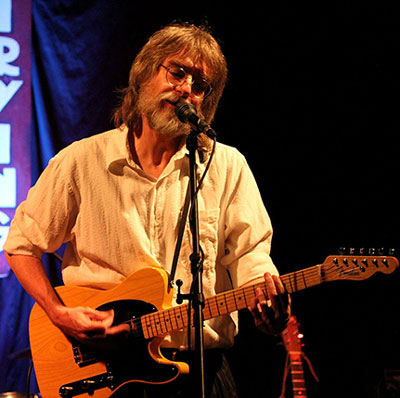 mwe3:
Tell us where you are from originally and where you live now. I know
you just came back from a road trip. Do you enjoying traveling, and
touring and what are some of your favorite cities to visit and perform
in?
mwe3:
Tell us where you are from originally and where you live now. I know
you just came back from a road trip. Do you enjoying traveling, and
touring and what are some of your favorite cities to visit and perform
in?
Bill Price: Born in Indianapolis, Indiana and except for my
time at the University of Cincinnati, I’ve lived In Indianapolis
all my life. I do like traveling. Most of my life, I’ve been
sort of a homebody, but several years back I started playing in different
states, just to experience that and I really enjoyed it. I’m
not sure that I’d want to do it constantly, but I do like getting
out of town frequently and seeing new places. I like playing new venues.
A change of scenery is good, I think. I’ll be playing out in
Montana, Washington and Idaho again this year, as well as North Carolina.
I’m really looking forward to those little tours. I should say
that I did a fair amount of traveling in the 1990s, before I really
began to focus intensely on music.
My favorite places tend to be based on geographic features, such as
mountains. Unfortunately, those areas are either terribly expensive
places to live or somewhat isolated, which means making a living there
is a bit trickier. So I’m currently pretty content where I am,
but see Indianapolis as a central location that I can travel from.
Plus, my roots, family and friends are here. My body is used to the
seasons here and the way the sun is at different times of the year,
which isn’t terribly important, but it’s something that
I notice when I travel to different places.
I love the Northern Plains, The Black Hills and most of all, the Northern
Rockies. I have a fondness for Missoula, Montana. It’s connected
to a few great memories from years ago. I’ve also driven around
Lake Superior two different times. It’s really wild and rugged
up there, which I like. I’d like to go back to the Southwest—Southern
Utah—but I keep getting drawn back to the Northern Rockies. For
big cities, Chicago is a pretty awesome place. I’ve not been
to New York or San Francisco, but I’m sure they have a personality
all their own. The older I get, the less interest I have in busy,
crowded places and the more I long for open spaces and blue skies.
So I’d better get to New York pretty soon, or I may never make
it.
mwe3: The mwe3.com web site received the single CD version
of your new album I Can’t Stop Looking At The Sky, which
you say is a distilled version for radio. It was sent by Peter Holmstedt.
How did you meet Peter? He is more knowledgeable about American music
than most Americans. Have you done any concerts in Sweden or other
parts of Europe? Do you have a world wide strategy to get the word
out about your new album?
Bill Price: I have a side project—a band called The Brains
Behind Pa. A few years back, we recorded an album called Better
for the Deal and ran an ad to promote it in No Depression magazine—back
when it was a physical, paper publication. Peter saw that ad, checked
out our music and contacted me. He’s been really helpful getting
my music some attention in Europe.
I’ve not been to Europe to play yet, although that is a goal
of mine. Hopefully this new project will help make that possible.
The strategy, if there is one, is pretty simple. I’m starting
with Europe, through Peter, since I’ve had much more recognition
there, than in the US. When that’s had some time to percolate,
I will start with some promotion in the US.
The challenge with promoting this project, is its format. I suppose
to help your readers put my answers in the proper context, I need
to give a bit of background and explanation about I Can’t
Stop Looking at the Sky.
In 2010, I was in need of a big break. I hadn’t been anywhere
for a long while and so I decided to return to my two favorite places:
The Black Hills in South Dakota and Glacier National Park in Northwest
Montana. Having recently become a fan of Lewis & Clark, I decided
to stop at some of their historic locations and like them, keep a
journal. In short, the trip was a life-changing experience. After
a little over three weeks, I came back with a lot of inspiration about
life. Some of the ideas were new and some were not. But even the older
ideas, I was reenergized about.
I had planned to return and record my next album. Through a series
of happy accidents, I found a lot of common themes in the songs I
wanted to record. I was also inspired to write some new songs about
these same themes: time, home, sense of place, childhood, grace, forgiveness,
truth and paradox. These were all very universal kinds of themes,
but that’s what I was addressing.
By adjusting some lyrics and writing some new songs, I thought that
the project could be a pretty cool thematic piece. It grew into two
CDs with 34 tracks and over two hours and twenty minutes of music.
I eventually decided to include my 120-page journal, which was never
the intent. And because I enjoyed working on the journal, I ended
up writing a 160-page book of short stories, essays and poems as a
kind of parallel, companion piece to the music—covering the same
themes. While there isn’t a narrative per se, there is a kind
of evolution of thought that takes place over the course of the songs.
The package then got pretty elaborate, due to my graphic design background.
In addition to the music, there are also two, 40-page oversized lyric
booklets, buttons, posters and postcards. So I now have this crazy
project. I did not set out on my trip with the intent of creating
music or writing about it. The idea evolved in its own way—kind
of asking to be done—in a rather organic fashion.
Back to your question about promotion. It is cost prohibitive to send
the entire package out to everyone that I’d like to, for a review.
Plus, the time involved to review it, is substantial. Thus, the sampler
was created. But that limits what people can say about it, as it includes
only 16 of the tracks and has none of the other materials. I’ve
created sort of a nightmare project, in terms of promotion—especially
as an independent artist. But, such is life.
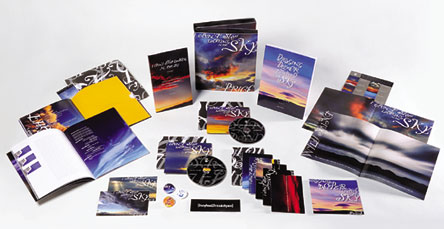 mwe3:
The band you feature on I Can’t Stop Looking At The Sky
is excellent. How did you assemble the band? Your guitars sound amazing!
What guitars are featured on the album and tell us about the other
guitarists on the album.
mwe3:
The band you feature on I Can’t Stop Looking At The Sky
is excellent. How did you assemble the band? Your guitars sound amazing!
What guitars are featured on the album and tell us about the other
guitarists on the album.
Bill Price: I agree—the players and singers that perform
with me are some of the best around and I have the utmost respect
for their talents. Many of the people I used on this album, I’ve
used before. Most of them are unique in some way, whether it’s
their voice or their playing style. I am looking for people who are
creative and can create parts that compliment my songs but can also
take some direction. There are a lot of flashy players who can fill
up every measure with impressive dexterity, but that’s not what
my music requires.
The core band on this record, which I also used on my last record,
does have some sort of chemistry. There are also no big egos or thin-skinned
people involved. Jamey Reid is a tremendous drummer and percussionist—so
positive, full of ideas and always so well prepared. Jeff Stone is
great bass player—creative and such a steady, calm presence in
the studio. Garry Bole has been on all of my albums and has a really
unique style that’s hard to categorize. I really love his unpredictable
playing. Grover Parido is such an asset on cello. He and I have played
quite a few duo shows together. He’s classically trained, but
able to create and improvise on the fly. He’s also well prepared
and has a wonderfully positive personality. Those guys along with
Paul Holdman and myself were probably involved the most. All of them
are really easy to work with. Bill Mallers also played some great
keyboard parts and Michael Clark played on some tracks. Both of them
are wonderful as well. There are a few other players that contributed
to a lesser degree, but not any less, in terms of talent and creativity.
Stasia Demos, Sarah Grain and Butch Rice also turned in wonderful
performances with their harmonies. So I think everyone did a fantastic
job.
As far as guitar players, Paul Holdman and I played most of the guitar
parts on the album. Michael Clark played some dobro, lap steel and
pedal steel. Michael is a veteran and has played with some of the
big names in the business including John Mellencamp and Sam Bush.
Michael is also another great personality to work with.
Paul I’ve known since my first album. I met him through Gordon
Bonham (my Brains Behind Pa collaborator). Paul is simply a
great guitarist. I am constantly amazed his creativity and musical
flexibility. I always say, he could play with any band out there.
Like the other people on this project, his attitude is great—always
striving for something new and unique, but appropriate. From my perspective,
his greatest attribute is his ability to create complimentary guitar
parts. My parts are usually pretty simple, but Paul is able to create
a second guitar part that’s not just doing the same thing as
mine. It’s pretty amazing. Sometimes, Michael Graham (my engineer)
and I will isolate Paul’s track just to hear how unique it is.
It usually has something pretty cool going on within itself. He rarely
repeats himself as well. He’s also got great tone, which is really
important to me. Paul’s played with some great performers as
well, including Tad Robinson. He’s got a duo that focuses on
gospel blues music and is a really good songwriter.
Paul and I used a whole bunch of different guitars and amps on this
project. Some of them we borrowed. Most of them are vintage. Paul
played a lot of tracks through his Silverface Fender Deluxe Reverb.
He also used a ’68 Fender Princeton and a ’65 Fender Vibrolux.
He played a ’59 Guild Thinline, a Gibson 330 and 335 (both from
the 60s), a mid-60s Harmony Bobkat and a 60s Mosrite.
I played a 1962 reissue Fender Strat, a ’52 Reissue Telecaster,
a ’62 Reissue Telecaster, a 80s Rickenbacker 620-12 (similar
to the Tom Petty Damn the Torpedoes lp cover), a ’74 Rickenbacker
480, a Hammertone mandotar, a ’61 Guild T-100, and a 620 Rickenbacker
set up with humbuckers for ebow. I was also fortunate enough to be
able to borrow a 1968 Gibson 330 from my cousin.
I played a lot of the acoustic tracks with my ’99 Martin D-28,
some with a ’60 Gibson J-45 and one track with a ’68 Martin
D-12 20 (12-string). I also played a Fylde Bouzouki and Fylde Cittern.
The amps I used were a ’65 Fender Tremolux, a ’66 Fender
Twin Reverb, a ‘94 Fender Blues Deville, a ‘50s tweed Fender
Princeton, a mid-60s Supro, a small National amp, and a big Marshall
amp (from the studio) that I can’t remember what model it was.
I also played a few guitar parts through a Leslie speaker.
Lastly, we used a couple of custom-made amplifiers. One was designed
and built by Dave Jones of Hook Amplifiers, the model is called The
Admiral and has an amazing tremolo. The other was designed and built
by Kevin Silva of Uncle Albert’s Amplifiers. It was similar to
a 50s tweed Twin Reverb. Both of those guys make great amps and are
based in Indianapolis.
I’m probably missing something, but that gives you some idea
of how we tried pretty hard to work on getting good and unique guitar
sounds. We were lucky to have access to a lot of that equipment.
 mwe3:
The box set version of I Can’t Stop Looking At The Sky
is amazing. It features two books that you wrote and it’s filled
with some amazing parts and unusual items! I think you were saying
something about not wanting to mix your music with your graphic art
background but I think it works great on I Can’t Stop Looking
At The Sky. So you’re really a triple threat as a singer-songwriter,
a graphic artist and an author / writer. How do you think the I Can’t
Stop Looking At The Sky box set blends these different sides of you?
mwe3:
The box set version of I Can’t Stop Looking At The Sky
is amazing. It features two books that you wrote and it’s filled
with some amazing parts and unusual items! I think you were saying
something about not wanting to mix your music with your graphic art
background but I think it works great on I Can’t Stop Looking
At The Sky. So you’re really a triple threat as a singer-songwriter,
a graphic artist and an author / writer. How do you think the I Can’t
Stop Looking At The Sky box set blends these different sides of you?
Bill Price: Thanks. In the past, I have tried to separate my
graphics from my music, only in the sense that if a graphic client
knows that I play music, they may not think I’m as serious about
graphics as, say, a small design studio. Likewise, there’s a
stigma, at least I think there is, about a musician who is not a “full-time”
musician, not being the “real thing.” If you have to support
yourself with another job, then you’re not a legitimate “professional.”
It’s sad, but I do think that exists. In fact, I know it does.
I tried to get a particular retail site/store to carry one of The
Brains Behind Pa albums and the first thing they asked was, “Do
people in your band have other jobs?” Now what that has to do
with the music, I don’t know. But it was some sort of litmus
test for them.
Anyway, I don’t worry about that anymore. I’ve always done
my own graphics for my music anyway, but just never felt the need
to list myself as the designer. In fact, I didn’t on this project
either, although I’m letting people know after the fact that
I did the design because I think this package is pretty unique and
it’s important in communicating the theme of the project.
As far as the songwriter/graphic designer/writer aspects blending
together, I guess I’d have to say that this sort of a project
lends itself to that because it’s a bit “old school.”
People don’t use print like they used to. Everything is digital
and online. But I still like ink on paper. I love the printing process.
The whole graphics industry has changed dramatically since I started
in it. It’s much more technology-driven now. I have a big collection
of pieces in my attic—kind of an archive—of samples from
paper companies. Examples of foil stamping, fancy die cuts and so
forth. The paper companies used to create the most elaborate promotional
pieces and give them out to art directors and graphic designers to
urge them to use their brand of paper. I still love that sort of thing.
That was always our goal as design students—to get that kind
of project to work on, with that kind of budget. That’s all changed
now. Anyway, that’s why I designed the elaborate package.
Lastly, I really love typography. And the use of words as a writer
and songwriter has an obvious literal connection to the way words
look, which is typography. I love the way letters look and the way
words sound. They are powerful things—words. So this package
allowed me to be very creative with my own words in an additional
way, through the typography. And I love photography as well. I used
to do a lot of nature photography, but couldn’t do that, music
and graphic design, so I had to give it up. But it was fun to find
beautiful sky photos taken by talented photographers to work with.
mwe3: How would you compare I Can’t Stop Looking At
The Sky with your earlier albums made in the early 2000s? How
has your songwriting evolved on I Can’t Stop Looking At The
Sky and do you think it’s your ultimate statement as a recording
artist? Tell us something about your earlier albums. Are they still
in print on CD or another format?
 Bill
Price: All my albums are different. Perhaps not dramatically,
but I try to have some sort of theme to each of them—if not an
editorial/content theme, then at least a musical approach or sonic
palette—so that they feel like an entity unto themselves. This
album is certainly the most eclectic and experimental project I’ve
done, although it doesn’t go very far in that direction, except
in terms of the presentation, with the book, journal and packaging.
I think instrumentation and songwriting-wise, it’s probably closer
to my first album (Bones & Apples) than either of the two Brains
Behind Pa records or my last album (With the Eye of a Skeptic), which
was an all-acoustic project. The songs were also more narrative and
traditional singer-songwriter in nature on the Skeptic album.
Bill
Price: All my albums are different. Perhaps not dramatically,
but I try to have some sort of theme to each of them—if not an
editorial/content theme, then at least a musical approach or sonic
palette—so that they feel like an entity unto themselves. This
album is certainly the most eclectic and experimental project I’ve
done, although it doesn’t go very far in that direction, except
in terms of the presentation, with the book, journal and packaging.
I think instrumentation and songwriting-wise, it’s probably closer
to my first album (Bones & Apples) than either of the two Brains
Behind Pa records or my last album (With the Eye of a Skeptic), which
was an all-acoustic project. The songs were also more narrative and
traditional singer-songwriter in nature on the Skeptic album.
The lyrics on the Sky project are much more open-ended. I wanted
it that way. My hope is that, like the journey/trip that I took, the
listener might be able to sneak into the lyrics and inhabit them for
a while and create their own journey. That’s why I grouped the
songs in what I called dispatches—like chapters and wrote the
little dream-like story in the lyric booklets that runs between the
dispatches—to get the listener/reader in the mindset of going
on a journey.
So I guess to answer your question, this album is much more thematic
and far more involved in terms of production and presentation than
my other albums. Honestly, I don’t know if it’s my best.
I’m pretty sure it’s as least as good as my previous albums.
All my albums are still available from www.billprice.info
and CD Baby and, in digital format on iTunes.
As far as my songwriting goes, for me, it’s important to differentiate
between songwriting and recording/arranging. In terms of arranging,
I think I’ve recorded enough songs to be willing to be a bit
more experimental in the future. There’s always a desire to record
something like some existing song or look at a favorite artist and
want to do something similar. I’ve kind of done enough of those—checked
enough off the list, so to speak—that I’ve satisfied those
urges. I never want to copy anything too close, but you can’t
help but be inspired by certain approaches.
In terms of the actual songwriting, it’s a really hard thing
to pin down. It’s such a mystical process that really has no
pattern or rules to it. I’m just fascinated by the entire process.
Where the songs come from, how they are arranged, what instruments
are used and how they are played live. From the very seed of the idea
to the final recording, is, when it works well, such an amazingly
satisfying and cool experience.
What’s interesting to me about the songs on I Can’t Stop
Looking at the Sky is the fact that some of them are really new—songs
that were inspired by my trip west. Others are old. A couple of them
are really old—over 25 years. They were just never finished or
their time hadn’t come. So I’ve had people tell me that
my songs have gotten better, when in fact, some of the ones they cite
are actually older.
I am at the point where I want to look for new approaches. I’ve
found myself doing some similar things musically that I don’t
want to repeat and I know that I can always improve on melody and
different rhythms, etc. So I think I will just keep pushing to try
not to repeat myself in terms of technique and subject matter. I’m
sure I will, but I’ll keep fighting against that.
Using different guitar tunings is quite helpful to me. Being a limited
singer, I find my voice going to predictable and not very interesting
places when using standard tuning on the guitar. Alternate tunings
allow my voice to go to slightly different places that I might not
normally go to. There’s always a lot of room for exploration
in tunings.
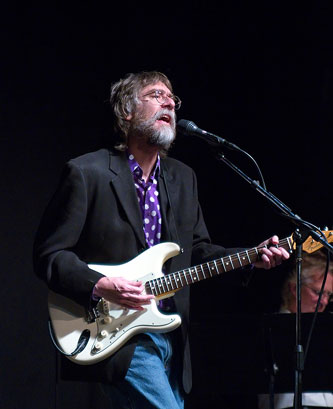 mwe3:
Can you tell us something about the way you recorded I Can’t
Stop Looking At The Sky and the way you worked with co-producer
Michael Graham? What is your studio set up like? I Can’t Stop
Looking At The Sky is superbly recorded, mixed and mastered so
there’s a lot to like just from a technology standpoint alone!
mwe3:
Can you tell us something about the way you recorded I Can’t
Stop Looking At The Sky and the way you worked with co-producer
Michael Graham? What is your studio set up like? I Can’t Stop
Looking At The Sky is superbly recorded, mixed and mastered so
there’s a lot to like just from a technology standpoint alone!
Bill Price: Again, thanks for the kind words about the quality
of the recordings. Michael Graham has engineered, mixed, mastered
and co-produced all my albums. I’m always amazed at how much
he has to know, and know well. Things like, how microphones are designed,
or the science of sound waves or how to use recording software. He
also understands music theory and is great at analyzing a performance
in technical terms. He worked really hard on this project. He always
works hard on my albums, but he stepped it up a notch on this one.
I always think, that you can say what you want about my songs, lyrics,
singing or playing, but I know for certain that my albums sound good.
The quality of the recordings is always really good. That’s all
Michael Graham. Usually, when we record, we get the core band together
and record the tracks live, but keep the instruments isolated. That
way, if we get a take with a great feel, but somebody’s hit a
clunker, we can fix that. I will usually sing a guide or scratch vocal
to help guide the band and then sing it for a final take later. We’ll
also add other instruments or harmonies later, but we usually try
to get the core band to record together live to get a good feel.
It’s kind of the best of both worlds to record that way. If we
do it right, we get the feel of real musicians playing real instruments,
but also have the flexibility to fix some things we don’t like
or add some addition parts without having the whole track sounding
like it was built perfectly in the computer. I think feel and dynamics
have as much or more to do with good music as technique and perfection.
What’s fascinating to me, is that most of the time, I will give
the band a simple demo—just vocal and guitar. I’ll have
some idea of a basic approach in terms of what instruments. Occasionally,
I’ll have some specific idea for a guitar riff or a general direction
for drums. But most of the time, the band is free to either improve
on my suggestions or come up with their own parts if I have no direction.
So the band will come up with ideas completely independent of each
other by listening to the demo.
Then we show up at the studio and we spend about an hour playing the
song and listening to playbacks to see how everyone’s parts work
or don’t work together. We discuss the arrangements and parts,
make adjustments and then spend another hour or so trying to get a
really good take/performance. Most of the time, that process works,
and works pretty well. In a couple of hours, we usually have a great
take with cool parts and it’s the core of what we work with.
There was only one out of 33 songs that we had to regroup later on
and try a new approach. So there’s a great chemistry to these
players. It’s a pretty fascinating process.
While we do make some edits and do some processing in the computer,
generally, Michael Graham and I take the approach that we should get
the instruments to sound the way we want them to sound—and then
record that sound. Many people record things totally dry and manipulate
the sounds later in the computer. We’re a bit more old school
on that. We also record almost everything organically. That is, we
don’t pull up sampled sounds on a keyboard or use a drum machine.
One of my favorites was dragging a really heavy steam radiator into
the studio so Jamey Reid could hit it with a lead pipe for a percussion
part. I love that kind of thing.
mwe3: Who else did you work with on the look and design of
the box set with the CDs, the books and booklets and all the posters,
postcards, stickers, buttons and even a bookmark! Just the design
alone should nominate I Can’t Stop Looking At The Sky
for a Grammy. Sometimes I wish every artist would release albums like
this.
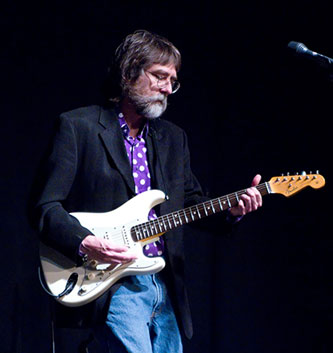 Bill
Price: I don’t think record companies like to invest in this
kind of packaging unless they’re pretty certain they can sell
a lot of copies. This was a labor of love for me and very painful
in terms of cost to produce. So I guess that’s a perk of being
an independent artist. Nobody can say “no.”
Bill
Price: I don’t think record companies like to invest in this
kind of packaging unless they’re pretty certain they can sell
a lot of copies. This was a labor of love for me and very painful
in terms of cost to produce. So I guess that’s a perk of being
an independent artist. Nobody can say “no.”
I did all the design and layout. As I mentioned, I scoured a lot of
my paper samples for ideas about the packaging. Just like writers
or songwriters, designers keep samples of things they like for future
reference. I also did the little pencil sketches in the journal. The
other illustrations—the more graphic ones—were done by Jim
Starr. He’s a really talented illustrator that I’ve worked
with in the past. He did the illustration on The Brains Behind
Pa Old Hat CD cover and the illustrations on my Skeptic album.
He’s quite versatile and great to work with.
Because one of the fonts I used, called Not Caslon, is so unusual,
it was a challenge to find an illustration style that didn’t
visually fight with it—mainly because the letterforms in that
font are almost like illustrations themselves. But we worked out,
what I thought was a pretty cool approach. Each dispatch has one illustration
that is based on a lyric in a song in that dispatch. But if you look
closely, you’ll see that the illustration is made up of a shape
of an item in another song, also from that dispatch. For example,
“Dispatch One” has an illustration of a little boy, because
there’s a little boy in the lyrics of “Taking Aim #1”.
But the little boy is made up from silhouettes of a sun shape—twisted
and distorted to form his image. It’s a small thing, but kind
of a nice little concept, I think.
The photographs were taken by eleven different photographers. Nina
Anthony is a friend that I worked with years ago and I knew she
had taken beautiful shots of the sky and mountains. The other photographers
were people that I simply located on www.flickr.com. They are talented
people that, not unlike me, are trying to get their work out for the
world to see. I did not want to use stock images and wanted the shots
to be from the part of the country that I traveled to on my trip,
and most of them are. Some are from exact locations that I visited,
which is pretty cool.
The shot on the journal cover is from Mount Sentinel in Missoula,
Montana, which is actually one of the really important places that
I talk about in my journal. Justin Whitaker took that shot. He came
out to one of my shows in Montana last year, so that was great to
meet him face to face. Mike Cramer took the shot on the cover of the
box and several others. We’re working together on a video of
one of the songs using his shots. So that’s been a really cool
benefit of this project—meeting other artists and making some
new friends.
I could go on about some of the things like the type fonts and printing
process, etc. that is of interest to me, but probably not so much
to music fans. I will just say that I’m a huge fan of typography
and leave it at that.
mwe3: What parts of America do you like the best and are there
still places you haven’t been that you think about visiting?
It’s amazing how Americans often relocate to other states to
live in and we strive to navigate the vastness of the U.S. Has the
internet changed that in some ways?
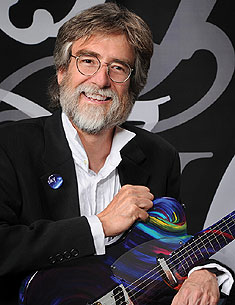 Bill
Price: I have always seemed to gravitate to the Northern Rockies.
I do love The Black Hills. Wyoming is beautiful as is Washington.
Idaho has an almost dangerously beautiful feel to it. I know that
sounds odd, but there are some areas in Idaho that are so rugged and
remote and beautiful all at the same time, it’s almost unsettling.
It’s like being in awe and in danger at the same time. But Montana—especially
Northwest Montana—is my favorite. Glacier National Park is a
magical place. I’ve been there six times and am going back again
this year. The Blackfeet call it “The Backbone of the World.”
Go there and you’ll see why. Of course, the Canadian Rockies
are spectacular. Waterton Lakes National Park, across the Canadian
border from Glacier National Park, is really beautiful. There’s
a park in Canada, Yoho National Park that is really spectacular and
I’d never even heard of it. There are so many places that I’ve
not been to, but oddly, or perhaps not, I find myself retracing the
general route of Lewis & Clark. All of the places I mentioned
are so vast, that I could spend the rest of my life exploring them
without retracing my steps. Glacier National Park alone, has over
700 miles of trails. I’d love to eventually hike every mile.
I’d like to take the Lolo trail over the Bitterroot Mountains—the
trail Lewis & Clark took in 1805 and nearly starved. The trail
is there. It’s been there for hundreds of years—having been
used by Native Americans for generations. I hiked a small portion
of it in 2010. I’d love to hike the Continental Divide trail,
but that’s a pretty tall wish.
Bill
Price: I have always seemed to gravitate to the Northern Rockies.
I do love The Black Hills. Wyoming is beautiful as is Washington.
Idaho has an almost dangerously beautiful feel to it. I know that
sounds odd, but there are some areas in Idaho that are so rugged and
remote and beautiful all at the same time, it’s almost unsettling.
It’s like being in awe and in danger at the same time. But Montana—especially
Northwest Montana—is my favorite. Glacier National Park is a
magical place. I’ve been there six times and am going back again
this year. The Blackfeet call it “The Backbone of the World.”
Go there and you’ll see why. Of course, the Canadian Rockies
are spectacular. Waterton Lakes National Park, across the Canadian
border from Glacier National Park, is really beautiful. There’s
a park in Canada, Yoho National Park that is really spectacular and
I’d never even heard of it. There are so many places that I’ve
not been to, but oddly, or perhaps not, I find myself retracing the
general route of Lewis & Clark. All of the places I mentioned
are so vast, that I could spend the rest of my life exploring them
without retracing my steps. Glacier National Park alone, has over
700 miles of trails. I’d love to eventually hike every mile.
I’d like to take the Lolo trail over the Bitterroot Mountains—the
trail Lewis & Clark took in 1805 and nearly starved. The trail
is there. It’s been there for hundreds of years—having been
used by Native Americans for generations. I hiked a small portion
of it in 2010. I’d love to hike the Continental Divide trail,
but that’s a pretty tall wish.
I think the danger of the internet is—and I mentioned this in
my journal—that everything is so documented now, that you can
spoil your sense of surprise and discovery by watching too many videos
and seeing images of where you plan to go. I’d advise anyone
to look at just enough to pique your interest, but not so much that
you know exactly what to expect. That being said, there’s no
video or photography that comes anywhere near to actually being there
in person. So it might spoil some of the surprise, but will never
be in danger of replacing the experience.
mwe3: The CD part of I Can’t Stop Looking At The Sky
features two different CDs with different artwork. Why did you divide
the 33 tracks into “Sun Up” (on disc one) and “Sundown”
(on disc two)? I was thinking that I Can’t Stop Looking At
The Sky is kind of like your version of the “White Album”
just from a prolific songwriting viewpoint.
Bill Price: That’s a great compliment about The White
Album. My songs, of course, are not at the same level of quality
and not near as varied as those on The White Album, but the
comparison is interesting. It’s a long story that I won’t
go into here, but the idea of a two-CD album initially seemed totally
uninspiring to me at first. It was only when I noticed the common
themes and had the inspiration for new songs that I began to see the
potential for a larger project and the possibilities that a two-disc
project held. Some of the songs that have a second version or a part
one and part two, really only worked in a two CD format.
Some of my all-time favorite albums are double albums, which people
rarely do anymore. The White Album would be one of them. Dylan’s
Blonde on Blonde, George Harrison’s All Things Must
Pass (actually a triple album), Fleetwood Mac’s Tusk,
ELO’s Out of the Blue and The Who’s Quadrophenia.
I love all of those records and the fact that they have such a variety
and depth to them. So when I looked at the project as a double-disc
set AND being a thematic piece, I got really, really excited about
it and the artistic possibilities. Eventually, the book of short stories,
essays and poems, and the journal were extensions of that inspiration.
As I mentioned, none of those things were planned ahead of time. The
project kind of just kept feeding off of itself and was asking to
be done, so to speak.
There are four reasons, I suppose, why the two discs are called Sun
Up and Sun Down. The main one is that the concept of time
is one of the major themes and this was a way to emphasize the passage
of time. Secondly, it’s a lyric from one of the songs—“Wild
Saint”. Third, is that the sun is one of the three main nature
metaphors running through the project, so it ties into that. Lastly,
I always remembered that Paul McCartney album, Back to the Egg,
where side one is Sunny Side Up and side two is Over Easy.
I always thought that was kind of cool. Why does it have to be called
side one and two? You could name one side Roger and the other Wilco
if you wanted. There are no rules.
mwe3: Tell us about your musical influences. What Dylan albums
are your favorites and I was thinking that your music would be a great
fit for fans of Springsteen and Jackson Browne as well. Give me 5
classic albums that still get you excited about and five albums that
you’ve listened to this year.
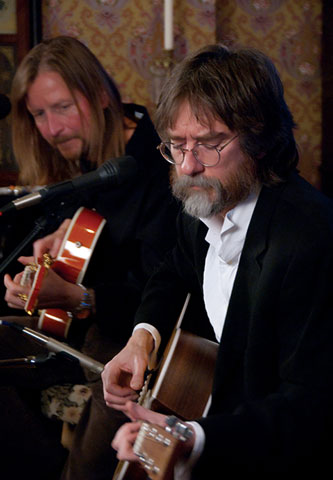 Bill
Price: I like a lot of things, but my tastes are not terribly
eclectic. The Beatles and Bob Dylan are my two strongest influences,
which sounds terribly unimaginative and boring, but hey, name me two
better than those. I’ve always thought that McCartney and Dylan
were the two best singers ever and for totally different reasons.
Lennon and McCartney wrote so many great songs. Just take some supposed
so-so Beatle song like “Hey Bulldog”, for example. That’s
such a great song and it’s not even mentioned as one of their
best. It’s the same with Dylan. If I’d written “Jokerman”
or “Hey Bulldog”, people would be calling me the new Dylan
or Beatles or whatever, and yet those aren’t even considered
their best work. The Beatles and Bob Dylan are just miles and miles
beyond the rest of us.
Bill
Price: I like a lot of things, but my tastes are not terribly
eclectic. The Beatles and Bob Dylan are my two strongest influences,
which sounds terribly unimaginative and boring, but hey, name me two
better than those. I’ve always thought that McCartney and Dylan
were the two best singers ever and for totally different reasons.
Lennon and McCartney wrote so many great songs. Just take some supposed
so-so Beatle song like “Hey Bulldog”, for example. That’s
such a great song and it’s not even mentioned as one of their
best. It’s the same with Dylan. If I’d written “Jokerman”
or “Hey Bulldog”, people would be calling me the new Dylan
or Beatles or whatever, and yet those aren’t even considered
their best work. The Beatles and Bob Dylan are just miles and miles
beyond the rest of us.
I like so many of the “Son of Bob” (Dylan) songwriters,
as I like to call them. Bruce Springsteen, Tom Petty, Neil Young.
Mark Knopfler is the rare combination of an incredible writer and
astounding guitar player. There are very few like that. Breaking out
of the 1960s & 70s influences, I love Counting Crows, Wilco, The
Waifs, The Jezabels, The Weakerthans. Others in more of the traditional
singer-songwriter vein include, Peter Case, John Gorka, Bruce Cockburn,
Jackson Browne, The Indigo Girls, Steve Forbert and Tracy Chapman.
I love Tom Waits, Paul Simon, Elvis Costello, Buddy Miller, Pete Townsend,
Jeff Lynne, Lindsey Buckingham, Rickie Lee Jones, Neil Finn, Michael
Penn. A couple of newer songwriters I like are Joe Pug and Ben Howard.
There are just so many and to be honest, I don’t have a lot of
time to explore all the new music that I should.
My favorite Dylan albums tend to change a bit, although Blood On
The Tracks and Blonde on Blonde are always fighting for
one and two. The first time I heard “Tangled Up in Blue”,
I was really taken aback. I thought, ‘What is this about?’
He was creating something that I couldn’t even describe in terms
of mood and attitude. I still remember that. The same is true when
I first saw a clip of “It’s Alright Ma” from Don’t
Look Back. I’d just never seen or heard anything remotely
like that—that combination of words, sound/voice and attitude.
Highway 61 Revisited would be in the top five. I love his gospel
albums as well. I also really like Street Legal. I think that
is such a powerful album. The lyrics are so visual and rich on that
album. It’s actually one of the biggest influences on me, in
terms of his approach to lyrics. What I love about Dylan’s lyrics
is that they are so visual. Plus, many times the sound of his lyrics
are great. He also has such a command of the English language. I could
go on quite a bit. New Morning is cool. Time Out Of Mind,
Oh Mercy, Bringing It All Back Home, Infidels. All of those are
just stunningly good, in my opinion.
Five classic albums that I still get excited about? Wow. This is fun.
Dark Side of the Moon, Sgt. Pepper, Blonde on Blonde, Who’s
Next and… Can’t Buy a Thrill. Five albums I’ve
listened to recently. New (Paul McCartney), Face the Music
(ELO), Sky Blue Sky (Wilco), Full Service No Waiting
(Peter Case), I Forget Where We Were (Ben Howard)
mwe3: Is there going to be a single from the I Can’t
Stop Looking At The Sky album? I think “I Don’t Want
To Come Home” would make a great single. What’s the inside
story on that track? The energy on that song is quite impressive.
Bill Price: I kind of leave the radio promotion up to the folks
I hire for promotion. It seems to make sense for me to simply send
the entire album, or in this case a sampler, to the radio people and
let them play what they want. At least that’s how Peter and I
have approached all my projects up to this point. So far, it’s
a pretty wide variety of songs that have been played. I haven’t
seen one song that seems to be getting more airplay than any others,
although “I Don’t Want to Come Home” has certainly
been one of them.
That song comes early in the project and is reflective of some of
the tension and frustration that I was feeling before I left on my
trip. It’s also how I felt when it was time to come home. I really
didn’t want to. Home is one of the project’s themes and
the bridge has a little suggestion about childhood, which is another
theme. The third verse about not being able to come home, but also
not being able to truly leave home was inspired by a Maya Angelou
quote—kind of a paradox. Paradox is yet another theme. It also
has a phrase about “familiar as the back of my hand.” Hands
are one of the metaphors running through the project—that represent
action or our life choices. So it’s a song that is critical in
setting the stage for the evolution of thought that happens as you
go through the project.
As far as the recording/instrumentation and arrangement, I had the
chords, melody and main guitar riff and we just worked on it from
there. I liked the idea of using the cello and accordion, which are
very organic and textural along with Paul’s almost surf guitar
approach. Garry Bole played a crazy-cool accordion solo. But like
most of the songs, given the simplest of demos, the band came together
and brought really cool parts. We adjusted them slightly to get them
to work together and there you have it. It’s a good example of
what I mentioned earlier. That is, how these particular players have
a certain chemistry.
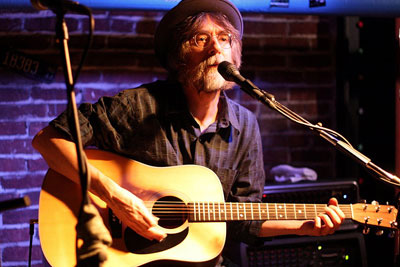 mwe3:
I like the way the title of the album is refrained in the song “Wild
Saint”. Tell us about that song and how you refrain the chorus
mentioning the title I Can’t Stop Looking At The Sky.
mwe3:
I like the way the title of the album is refrained in the song “Wild
Saint”. Tell us about that song and how you refrain the chorus
mentioning the title I Can’t Stop Looking At The Sky.
Bill Price: “Wild Saint” is one of the songs
that is probably twenty years old, but really important to the project.
I had the basic concept, which is, that we’re all born with some
connection to the natural world and/or what our natural or true calling
is. I think that to truly be yourself is kind of a holy thing. So
that’s the basic idea of what a “Wild Saint” is—someone
connected to their true, natural self or trying not to loose that
or trying to rediscover that. In my case, it had more to do with my
love of the natural world or wilderness juxtaposed with my continual
frustration with our current society and culture and what it values.
Even though I had the idea, the music and most of the lyrics, the
song was never really quite finished. It had some pretty lame lyrics
that I knew needed to be changed.
On my trip, I was driving north from Missoula up to Glacier National
Park and off to my left, the western sky was doing some sort of crazy
alchemy thing. I don’t even remember what it was exactly—some
spectacular combination of clouds, sun and rain—so unusually
beautiful that I couldn’t take my eyes off of it. I kept looking
to my left and consequently drifting off onto the shoulder of the
highway. In frustration, I actually said out loud, “I can’t
stop looking at the sky!” I finally thought, “This is one
way people die in car wrecks.” I had to force myself not to look
at the sky. I seem to remember actually thinking about that song at
that moment, but I’m not sure. Regardless, at the end of the
day, when I was doing my journal entry, I wrote about that experience
and wrote the line down. The sky became such a major metaphor for
grace, optimism and that childlike enthusiasm—when we dream and
the sky’s the limit and we are more innocent and connected to
our true selves—that I realized it would be a great line in “Wild
Saint”, to help finish off the lyrics and would help the song
fit nicely in the project. I thought it would also make for a great
title for the project. Well, I don’t know if it’s great,
but it’s very meaningful to me personally.
mwe3: What’s been the world wide reaction to I Can’t
Stop Looking At The Sky and how are you planning to reach such
a vast market? Is that daunting to you, not only that it’s so
easy to reach a big market through the internet but that it’s
often down to the artist to do a lot of the work! Even so, what other
musical plans are you putting together for this year?
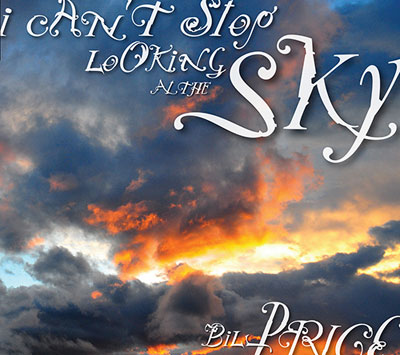 Bill
Price: It’s kind of early to say. I’ve gotten some good
reviews back and some airplay in Europe. As I mentioned, once that’s
had some time to percolate, I’ll see what I can do in the US.
It’s really difficult as an independent artist to promote projects.
The time and resources are a challenge. This project really drained
the bank due to the elaborate packaging, but I’ll just keep pushing
ahead as I always do and see what happens. Unfortunately, the cost
to ship one of these to Europe is pretty expensive, which will not
help physical sales any. But the songs are available as downloads.
Shipping won’t be nearly as big of a problem in the US.
Bill
Price: It’s kind of early to say. I’ve gotten some good
reviews back and some airplay in Europe. As I mentioned, once that’s
had some time to percolate, I’ll see what I can do in the US.
It’s really difficult as an independent artist to promote projects.
The time and resources are a challenge. This project really drained
the bank due to the elaborate packaging, but I’ll just keep pushing
ahead as I always do and see what happens. Unfortunately, the cost
to ship one of these to Europe is pretty expensive, which will not
help physical sales any. But the songs are available as downloads.
Shipping won’t be nearly as big of a problem in the US.
The internet is indeed vast, but people still have to find you. They
also should have to pay for something, I think. Also, there are seemingly
an unlimited number of songwriters and musicians out there all competing,
so it’s not been easy to get noticed or to make a buck.
I’m doing a little five-show, acoustic duo tour in North Carolina
in June and a more extensive tour in Montana, Idaho and Washington
in July, both with Grover Parido on cello. In late summer, I hope
to stage this entire project with many of the musicians and have the
event filmed and turned into a promo. My hope is to offer this project
as a kind of stage production for performing arts venues, small theaters
or universities. I want to develop some nice visuals for the stage
set that tie into the package design. I have no idea if it’s
marketable or not, but I guess I’ll find out.
Lastly, I have recorded five songs that have similar subject matter
and cover some of the same themes as the Sky project. They
were not included in the project because they are lyrically a little
more direct and singer-songwriter in nature—more acoustic-based.
But they’ve turned out well, are mixed and will be released at
the end of the year as a follow-up EP. In fact, there’s a coupon
in the Sky project for it. So, lots to do by the end of the
year!

